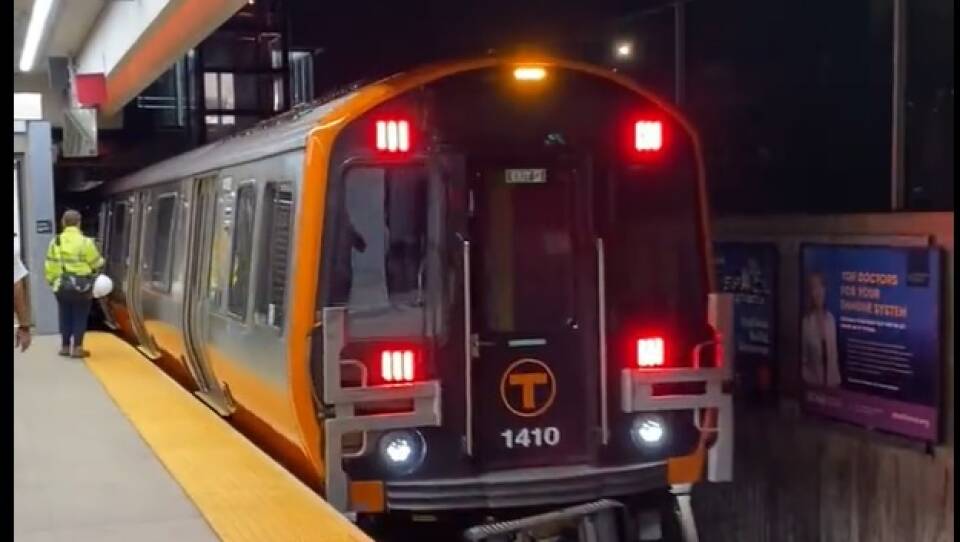After a 30-day shutdown, Orange Line trains are again rolling down the track. But that’s not the end of the T’s troubles. GBH News transportation reporter Bob Seay joined Morning Edition co-host Paris Alston to talk about what's happened over the past 30 days that the T's Orange Line was shut down and what we can expect moving forward. This transcript has been lightly edited.
Paris Alston: Here we are 30 days later. We've made it through the shutdown and all the shuttle buses. Are you at all surprised that the T was able to pull this off?
More Local News
Bob Seay: Well, I think we all were skeptical that this could be done, considering the T's past track record. And that's why this is such an important turning point for the T. I think the low point had to be the fire on the Orange Line train over the Mystic River. And today there is celebration at the MBTA and they have reason to celebrate. They actually pulled off something pretty miraculous in terms of shutting down the second-busiest line and providing shuttle buses for 100,000 riders a day. And at the news conference yesterday, General Manager Steven Poftak admitted that a lot of people doubted that they could get this done.
[Previously recorded]
Poftak: You know, I'm hopeful. I think a lot of people went into this not thinking it would work, or not thinking that we would get the work done in 30 days. And we've gotten the work done in 30 days. And my hope is when they come back, they appreciate that the product is better, that the ride is going to be faster, you're going to get more vehicles. It's going to be a smoother, more reliable ride. So I'm hopeful. To the extent that there are folks who have lost confidence in the T, I'm hopeful that this is a step in regaining that confidence.
[Recording ends]
Seay: And that is a key point, regaining the confidence and the trust of the riders. And that's really what's at stake here. If they had failed to do this, it would have been, of course, a further blow to the MBTA. Of course, the T is still facing many challenges. The Orange Line may be back, but the frequency is not back. And that's due to the lack of dispatchers. They've had to cut back to weekend service. It's been very frustrating for commuters who have to wait 10 to 15 minutes or more at rush hour for the next train. So that dispatcher challenge is going to remain and it's going to take several weeks, if not months, to resolve.
Alston: So the T is going to have to work on that. But at least as of now, they do have presumably better service, newer cars and no more shuttle buses. Are there any other positives that came out of this shutdown?
Seay: People really did adapt. It wasn't comfortable. It wasn't convenient. It cost people a lot of time. But I think there was a general understanding that it might be worth it. And people did adapt. They did adapt to taking those shuttle buses. And, you know, a lot of them thought that the service was pretty good, that was provided. That's one thing we learned, that people can adapt. The second thing is that the use of bike lanes was very important, designated bus lanes, all of these things suddenly become very highlighted as essential elements of transit planning in downtown. So hopefully some of that will be retained as well.
Alston: So, Bob, I remember when the shutdown first began, we asked you what were the metrics you were going to be looking at to critique how the shutdown was going. And you mentioned things like how well the shuttle buses were running, whether they were getting people where they needed to be on time. So looking back over the past month, what's the grade that you would give the T for how it handled the shutdown?
Seay: Well, I would have to give it an A-minus, perhaps, because I think that they did defy expectations. They did provide shuttle bus service that for the most part, people thought was good, even though it cost them time commuting. But once again, this is a massive undertaking. The choreography, as Steven Poftak put it, to put all of this together, working 30 days, 24/7. And Poftak made a point of thanking all the MBTA workers for the extraordinary work that they did. And I also think that this success is going to enable the T to look to the future in terms of a similar strategy.
I don't think we're going to see an entire line shut down, but you can expect to see partial shutdowns. In fact, beginning next Saturday, there's going to be three nine-day-long shutdowns on the Green Line D branch (Sept. 24 to Oct. 2, Oct. 8 to 16 and Oct. 22 to 30). Now, this is something the T has been doing on the Green Line for quite some time, which is what gave them confidence to proceed with the Orange Line. You could see partial shutdowns on the Red Line in the future and in fact, again on the Orange Line, because work is not complete there as well. They've done the most essential work, but there will be other shutdowns ahead. So people should be used to and probably are getting used to those shuttle buses.
"I don't think we're going to see an entire line shut down, but you can expect to see partial shutdowns."GBH transportation reporter Bob Seay
Alston: You told us not too long ago that this was going to be a reality for many T commuters for the next few years. Hopefully they can at least bring those those nice shuttle buses with the starry ceilings and maybe some music, or something that'll help sweeten the deal. So, Bob, you mentioned those hiring challenges that the T is facing, but also we learned last week that there was had been criticism of the Department of Public Utilities for failing to oversee safety at the T. And we are still dealing with the fallout and responding to that report from the Federal Transit Administration on the T's safety challenges. So where are we with all of that?
Seay: The MBTA has gone ahead and created a separate office to deal with all of the recommendations from the Federal Transit Administration. I think that was a really good move, to take it out of the usual day-to-day management responsibilities of the T. The other thing that came up at that meeting, we saw the DPU really having to take a more active role in monitoring safety at the T.
There were a couple of employees who complained that sometimes their complaints went unanswered by T officials. And that's a real problem. There has to be a culture of safety. This is more difficult than fixing rails. This is, you know, getting human beings to agree and to work together, to feel that their complaints will be answered and responded to. And that's a very important thing that's going to be happening. A lot of the FTA report, beside, you know, pick up the pace of maintenance, is management and communication.
So there's going to be a lot of internal restructuring at the T to expedite that as well. All in all, I think the FTA report is a is a real great move forward to getting the T to engage in some of the most important work it has to do to reform. And I think we all want a successful T, we all want a rapid transit system that works in the city. And I think today's Orange Line opening and the success, knock on wood, so far is a real promising sign of what can be done, and hopefully we can move forward with that.









